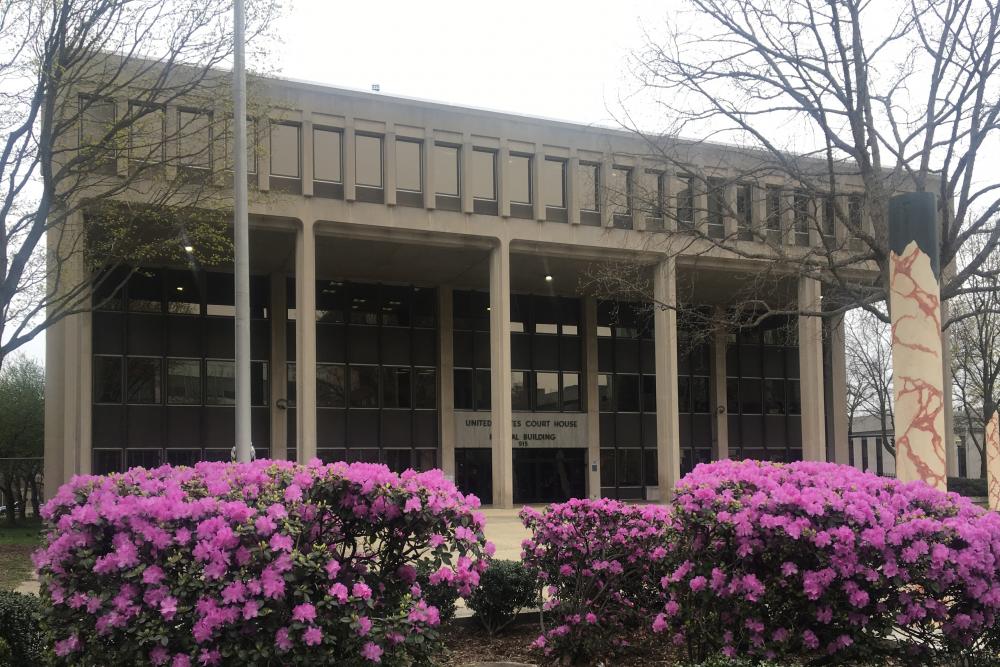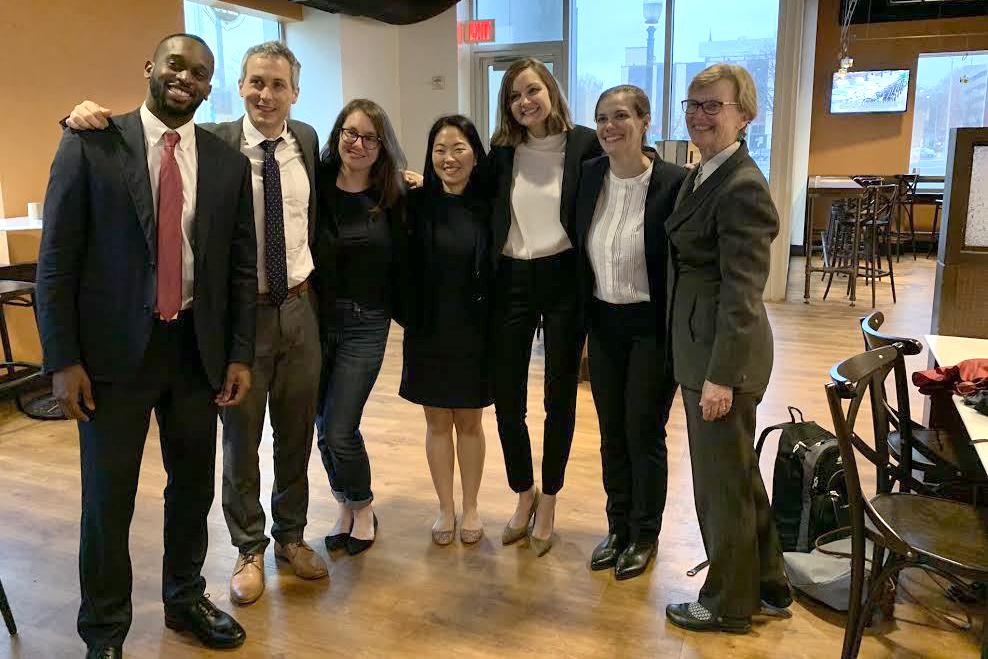Clinic Students Argue Constitutional Claims in Federal Court
In oral arguments, five members of Professor Brett Dignam’s Mass Incarceration Clinic sought injunctive relief for their client, a man who has been in solitary confinement for 24 years.
On a drizzly April morning in Bridgeport, Connecticut, Columbia Law School Professor Brett Dignam and five of her students from the Challenging the Consequences of Mass Incarceration Clinic were whispering among themselves in the somber Brien McMahon Federal Building. They were waiting for their client, Richard Reynolds—a convicted murderer whose death row sentence was changed to life in prison without the possibility of parole after Connecticut declared capital punishment unconstitutional in 2012—to enter the courtroom of Judge Stefan R. Underhill of U.S. District Court for the District of Connecticut.
Reynolds, who has been in solitary confinement for 24 years, arrived in shackles and dressed in a baggy orange prison jumpsuit. “The marshals didn’t allow Mr. Reynolds to change into the business suit I brought for him to wear,” Dignam said before the hearing. “But since there is no jury, it’s fine that he’s in his prison clothes, because the judge will be reminded of how Mr. Reynolds lives every day.”
Describing the emotional and physical deprivations that Reynolds endures every day as an inmate in “near-total isolation” at a supermax prison was a core part of the presentations by students Tyler Finn ’19, Sarah Hong ’20, Caleb King ’20, Hayley Malcolm ’19, and Mary Marshall ’20. Under the rigorous tutelage of Dignam—who has represented Reynolds pro bono since 2015—they argued that the conditions of Reynolds’ confinement violate the Constitution: the Eighth Amendment’s prohibition of cruel and unusual punishment, the 14th Amendment’s due process and equal protection clauses, and the ex post facto and bill of attainder clauses. They were asking the judge not only to order that Reynolds be moved from “permanent confinement in Special Circumstance High Security” into the general prison population but also to award compensatory damages, punitive and nominal damages, reasonable attorney fees, and “further relief as the Court deems just and proper.”
They also were being given the rare opportunity as students to appear before a federal judge and to face off against the Connecticut assistant attorney general representing the defendants, including the commissioner of corrections, various wardens, and a prison psychologist and psychiatrist. “It will be a long time before they get to argue another case of this magnitude in court,” Dignam said.
Making Their Case
The optics in the courtroom seemed to be in the state’s favor. Throughout the 90-minute hearing, two burly Department of Corrections guards dressed in black polo shirts and fatigue pants sat 20 feet behind Reynolds as if at any moment he might turn violent or try to escape. But the tableau of the earnest law school students sitting with him at the plaintiff’s table telegraphed that their client was not a monster but a human being who deserved to be treated with dignity and compassion.
The judge was familiar with the students’ arguments because he had read their 60-page and 40-page memoranda of law (and hundreds of pages of exhibits and other filings) in support of Reynolds’ motion seeking summary judgment for declaratory and injunctive relief. “Our most important advocacy happened before we stepped into the courtroom, in our briefs,” explains Malcolm. “During the hearing, it was clear that the judge had read the submissions carefully.”
For months before their court appearance, the students had been mooting with Dignam, who advised them “to speak half as fast and twice as loud as you think you should” when they took their turns addressing the judge. Malcolm says they were ready for anything: “The other side made a couple of arguments we had to respond to on the fly, but Professor Dignam had drilled into us that we needed to really know the record and every relevant case, so we prepared for that.”
After Malcolm presented an overview of the case, Hong offered a detailed description of Reynolds’ conditions of confinement: his lack of “meaningful human contact,” the unforgiving architecture of his 12-by-7-foot cell with its sliver of a window, and his cell’s often-backed-up toilet. “Mr. Reynolds has not been allowed to touch his loved ones in 24 years. He has only been touched by medical or court personnel and his lawyers when they shake his hands,” Hong said. (Reynolds’ loved ones include his mother, three siblings, three children, and two grandchildren.)
When King rose to address the judge, he challenged the state’s cross-motion claim that Reynolds is not being subjected to cruel and unusual punishment. Countering the state’s assertion that Reynolds’ treatment has improved in recent years, King contended that the conditions of his confinement “must be viewed in the aggregate.” He asked the judge to consider a declaratory judgment and injunctive relief that would protect Reynolds from future mistreatment, including invasive strip searches every time he leaves his cell and the denial of educational programming.
Marshall presented the affirmative equal protection claim. She described how two other Connecticut inmates—Eduardo Santiago and Terry Johnson—had also been on death row before being resentenced to life without parole. They were moved to a general prison population of 1,500 individuals and they are allowed contact visits with their loved ones. “The defendants have admitted that Mr. Reynolds could be handled in the general population,” where the difference for her client “would be like night and day,” said Marshall. But prison officials say they are merely following a law—which Dignam characterizes as “vindictive” because it requires him to be kept in solitary confinement.
A Memorable Day
Throughout the hearing, Underhill was courteous and respectful of the students. “Once I got up to the podium,” says Hong, “it truly felt like a conversation about the case between me and the judge. King adds, “I believe he treated the team as real lawyers and the hearing in a way that highlighted the gravity of the situation.”
The students say that their client’s active participation was central to the experience. “Truth be told,” says King, “the team owes him a great deal for being incredibly supportive and patient as clinical students worked on his case.” As Malcolm notes of Reynolds: “He knows his case better than anyone and was communicating with us throughout.”
Having Reynolds present for the hearing was meaningful for everyone involved. “I am so pleased that Mr. Reynolds was given the opportunity to attend the hearing. It wasn’t a guarantee that he would be able to be there, but Judge Underhill recognized the importance of having him there,” says Finn, who argued that Reynolds was denied due process because he was entitled to meaningful review of his conditions of confinement. “Regardless of the ultimate result, I think it is very important that Mr. Reynolds was able to see the fruits of the labor that all of us have put into this case and to recognize that his claims will get a fair hearing in court. He left very pleased with the way the hearing had gone and the reaction of the judge. He thanked us all individually afterward. I was happy to have the opportunity to shake his hand and let him know that it has been a privilege working to, hopefully, get him some relief.”
At the end of the proceedings, the judge left the bench to shake hands with each student, the assistant attorney general, and Reynolds. “It was a humble but powerful moment,” says Malcolm. Dignam and the students left the courtroom optimistic that the judge was receptive to their case. “I have to believe he’ll grant Mr. Reynolds some kind of relief,” says Marshall. “It cannot be constitutional for someone to spend the rest of their life in solitary confinement with no meaningful review or chance at better conditions.”
# # #
Published on July 2, 2019

